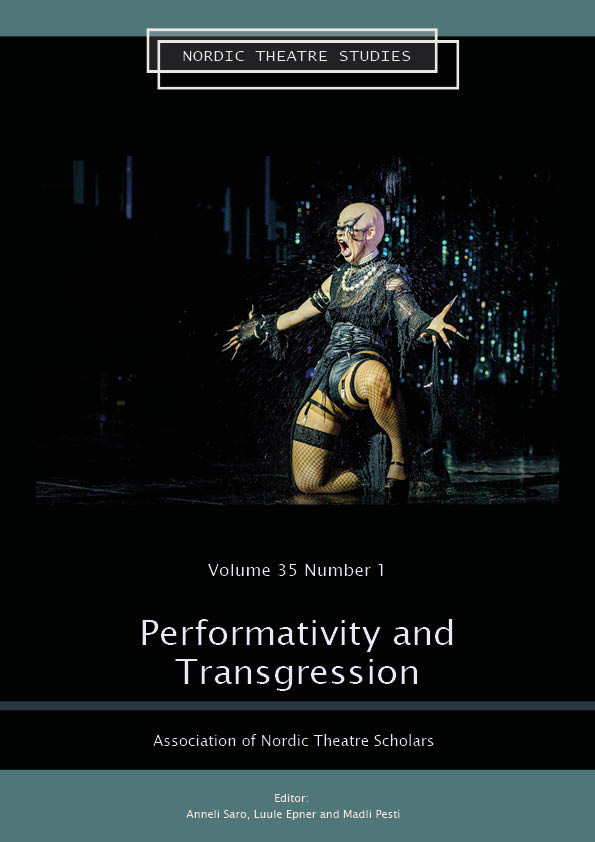Performances that Disappeared
Two Case Studies of Alternative Aesthetics during the Transition Period in Latvia in the late 1980s
DOI:
https://doi.org/10.7146/nts.v35i1.145377Keywords:
Experimental Theatre Studio, Theatre Studio No. 8, Ilmārs Elerts, Modris Tenisons, independent theatre, transgression, transition periodAbstract
The article explores the alternative theatre and performance culture of the late 1980s in Latvia focusing on two independent companies that were established in 1987, namely The Experimental Theatre Studio led by theatre director Ilmārs Elerts and The Theatre Studio No. 8 uniting young theatre makers who refused to join the dominant state-funded repertory theatres. Both companies existed only for a few years and their activities and impact on Latvian theatre have not been properly researched until now. The article suggests negotiating the inherited strict binary division in research between professional and non-professional or semi-professional theatre, as well as official and underground culture in case of artistically innovative practices and recognizing the rhizomatic nature of Latvian theatre processes. Both companies are remarkable because of their significantly different aesthetics from the mainstream Latvian theatre of the time. They could be regarded as performative transgressions in terms of both aesthetic choices and organizational models.
References
Akots, Normunds. 2007. “Neatkarīgie teātri.” In Guna Zeltiņa (ed.). Latvijas teātris: 20. gs. 90. gadi un gadsimtu mija. Rīga: Zinātne, 570–91.
Astahovska, Ieva and Vilnis Vējš. 2011. Un Citi virzieni, meklējumi, mākslinieki Latvijā 1960–84. Rīga: Laikmetīgās mākslas centrs.
Astahovska, Ieva and Māra Žeikare (eds.). 2016. Nebijušu sajūtu restaurācijas darbnīca. Juris Boiko un Hardijs Lediņš. Workshop for the Restoration of Unfelt Feelings. Juris Boiko and Hardijs Lediņš. Rīga: Laikmetīgās mākslas centrs.
Bērziņa, Ligita. 1995. “Hronika: Liepājas teātris.” In Silvija Radzobe, Edīte Tišheizere and Guna Zeltiņa (eds.). Latvijas teātris: 80. gadi. Rīga: Preses nams, 427–35.
Brook, Peter. 1996. The Empty Space. New York: Touchstone.
Bryzgel, Amy. 2018. “Special Issue: Artistic Reenactments in East European Performance Art, 1960–present.” ARTMargins Online 26.1. https://artmargins.com/artistic-reenactments-in-east-europe-introduction/ (30.8.2023).
Čakare, Valda. 1986. “Par diviem uzvedumiem, kuriem savā starpā nav nekā kopīga.” Literatūra un Māksla 28.3.1986, 5.
Edwards, Gwynne. 2014. “Introduction.” In Federico García Lorca. Plays: Three. London: Methuen Drama, xi-xxxv.
Gundars, Lauris. 1987. Septītais. The private archive of Zane Kreicberga.
Jenks, Chris. 2003. Transgression. London & New York: Routledge.
Jervis, John. 1999. Transgressing the Modern: Explorations in the Western Experience of Otherness. Oxford: Blackwell Publishers.
Kalna, Baiba. 2010. “Neatkarīgie teātri.” In Guna Zeltiņa (ed.). Latviešu teātris no pirmsākumiem līdz mūsdienām. Rīga: Latvijas Universitātes Literatūras, folkloras un mākslas institūts, 537–62.
Kalna, Baiba. 2012. “The Independent Theatres.” Translated by Maija Veide. In Guna Zeltiņa (ed.). Theatre in Latvia. Riga: Institute of Literature, Folklore and Art, University of Latvia, 179–90.
Klotiņa, Anda. 1986. “Kopā ar Balto un Sarkano klaunu.” Padomju Jaunatne 17.7.1986, 5.
Kreicberga, Zane. 2020. “Theatre Education in Latvia: Traditions and Challenges.” Translated by Inta Ivanovska, Laine Kristberga. In Lauma Mellēna-Bartkeviča (ed.). Contemporary Latvian Theatre: A Decade Bookazine. Riga: Latvian Theatre Labour Association, 74–85.
Kreicberga, Zane. 2021. “Latvian Theatre in Transition: The Roots in the 1990s.” Culture Crossroads. 19, 78–88. DOI: https://doi.org/10.55877/cc.vol19.30
Lauksargs, Jānis. 1988. “Bezpajumtnieki bez nosaukuma.” Rīgas Balss 3.6.1988, 6.
Leimanis, Arnis. 1987. “Septiņi rūķīši un celtniecība.” Liesma 1.11.1987, 3.
Raiskuma, Ieva. 1993. “Es neesmu pārliecināts.” Latvijas Jaunatne 13.8.1993, 4.
Rīgas pantomīma. Arheoloģija, historiogrāfija, arhīvs. 2021. http://www.mimeriga.com/xy_sakums (12.3.2023).
Tenisons, Modris. 1989. “Sirdssāpes.” Teātra Vēstnesis Nr 9–10 (1989), 49–52.
Tišheizere, Edīte. 2020a. “Teorētiska un vēsturiska atkāpe: performance.” In Edīte Tišheizere, Ieva Rodiņa, Dita Jonīte and Lauma Mellēna-Bartkevič. Neatkarības laika teātris: Latvijas teātra parādības un personības gadsimtu mijā un 21. gadsimtā. Rīga: Latvijas Universitātes Literatūras, folkloras un mākslas institūts, 391–94.
Tišheizere, Edīte. 2020b. ““Veco māju” pārvērtības. Īsais kurss.” In Edīte Tišheizere, Ieva Rodiņa, Dita Jonīte and Lauma Mellēna-Bartkeviča. Neatkarības laika teātris: Latvijas teātra parādības un personības gadsimtu mijā un 21. gadsimtā. Rīga: Latvijas Universitātes Literatūras, folkloras un mākslas institūts, 16–115.
Valtere, Edīte. 1992. “Teātris vai ilūzijas.” Latvijas Jaunatne 26.5.1992, 4.
Vējš, Vilnis. 2002. “Neinstitucionālās spēles mākslas formas Latvijā 70. un 80. Gados.” MA thesis in Arts, Latvian Academy of Culture, Riga.
Vējš, Vilnis. 2021. “Ar parāda sajūtu. Veltījums nonkonformistam.” Teātra Vēstnesis 2021/II (142).
Interviews
Ingrīda Elerte 6.10.2022. Interviewed by Zane Kreicberga. The private archive of Zane Kreicberga.
Lauris Gundars 4.10.2022. Interviewed by Zane Kreicberga. The private archive of Zane Kreicberga.
Viktors Runtulis 21.4.2021. Interviewed by Zane Kreicberga. The private archive of Zane Kreicberga.
Downloads
Published
How to Cite
Issue
Section
License
The copyright belongs to the authors and Nordic Theatre Studies. Users can use, reuse and build upon the material published in the journal but only for non-commercial purposes. Users are allowed to link to the files, download the files, distribute the files on a local network (preferably by links), upload the files to local repositories if their institutions require them to do so, but not republish the files without proper agreements with the journal and the author.

